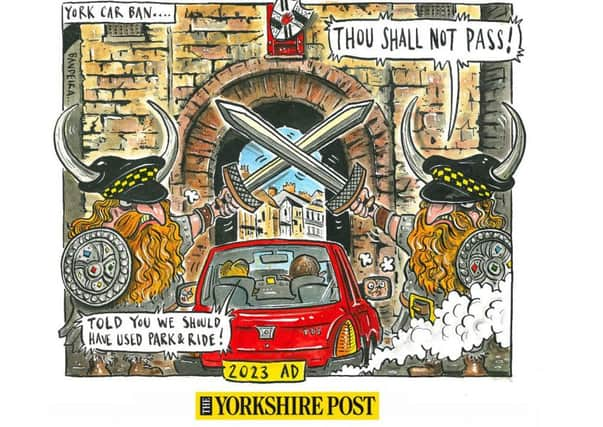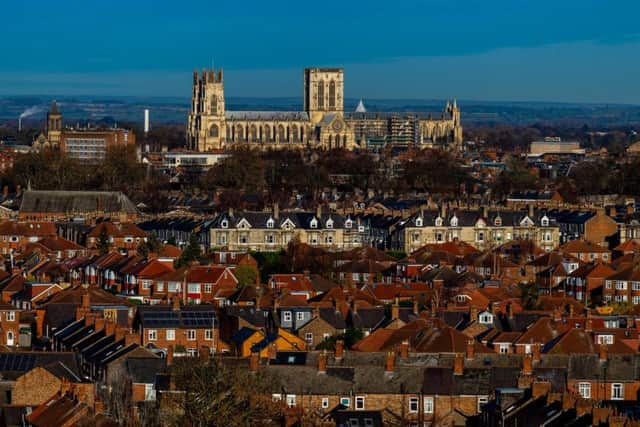Taking cars out of York city centre is a breath of fresh air – David Behrens


So the decision this week by the local authority to outlaw most private car journeys within the city walls had a ring of inevitability about it. Remove the cars and you remove the congestion.
The initiative would make York the first city in the country to declare its centre car-free.
Advertisement
Hide AdAdvertisement
Hide AdYet traffic jams hardly figured in the council’s announcement, which instead focused on cutting carbon emissions.


This was not without reason. On a pollution map released last year by Friends of the Earth, 12 locations in the central area exceeded the national standards for air quality. A bus stop on Rougier Street, just over the Ouse from Gillygate, was said to be among the most polluted spots in the country.
In taking action to remedy this, a degree of competition seems to have developed between local authorities. By choosing to make the announcement when it did, York was stealing a march on Bristol, which had previously declared itself the first diesel-free city by banning cars such as my red Fiat from its environs after next year.
Advertisement
Hide AdAdvertisement
Hide AdPerhaps it is Sir David Attenborough who is responsible for this sudden onset of social conscience; it can no longer be the fear of the tougher clean air regulations due from the EU.
But whatever the reason, the developments are welcome. For too long, local authorities have maintained an ambiguous stance towards car owners – discouraging them from town centres but relying on them to pay punitive parking charges and fines for the most trivial transgressions. Nearly £1bn a year now flows into our Town Halls from such sources, while public transport has remained expensive, uncoordinated and unreliable.
Radical thinking was what was needed to break the paralysis of policymaking and construct a different way forward for our town centres.
York, where a coalition of Liberal Democrat and Green councillors holds sway, was a good place to start the revolution. Its proposal – put forward by a Labour man, ironically – will end all “non-essential” car journeys within the city walls from 2023. The ban will apply to petrol cars as well as diesels, and probably also to electric vehicles.
Advertisement
Hide AdAdvertisement
Hide AdThere will be practical difficulties, obviously – not least for those who live within the city walls and remember the debacle of six years ago when Lendal Bridge and Coppergate were closed to traffic. The council’s botched implementation made the congestion worse, not better, and saw thousands of motorists wrongly fined for misunderstanding the signs.
It is also fair to say that what might work in a tourist hotspot like York, where visitors are abundant, will not necessarily be appropriate in centres the public has deserted. But there is no denying the change in the public mindset. By the end of this decade, the expectation that cars can go anywhere will have evaporated. No-go zones will have become the norm, and even diesel drivers such as myself will have accepted that some places will be better off without us. I do wonder how on earth I let myself be persuaded by the motor trade last summer that such engines were still worth the premium prices attached to them.
Advertisement
Hide AdAdvertisement
Hide AdI hope they can make York’s experiment work this time – not just because the city will look even more attractive when traffic no longer blocks the view – but because it will further help turn the tide of opinion. What is radical there will be considered conventionalist in the next place.
But the new thinking must not end there; it must extend to reimagining the very way we define our urban centres, and it must facilitate their transformation from purely commercial areas into mixed environments in which people live as well as work. The reduced need for retail premises in the age of online shopping has made available sites that are ripe for residential development, and far better suited to the purpose than the precious remaining areas of Yorkshire’s green belt.
Our towns and cities, whether thriving or struggling, must adapt to survive, and the discarding of stale old ideas is where their journey will begin. The wind of change blowing through York is a breath of fresh air.